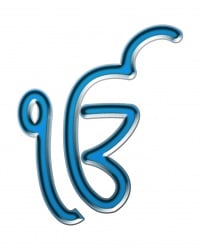Ek Onkar: Difference between revisions
Allenwalla (talk | contribs) mNo edit summary |
Hari singh (talk | contribs) |
||
| Line 33: | Line 33: | ||
== See also== | |||
{| | |||
|style="vertical-align:top; width:30%;"| | |||
* [[Mool Mantar]] | |||
* [[Learn Japji sahib]] | |||
* [[Mool Mantar media]] | |||
* [[Japji Mool Mantar]] | |||
* [[Mool Mantar Gallery]] | |||
* [[Mool Mantar's handwritten by the Gurus]] | |||
* [[Maha Mantar]] | |||
|style="vertical-align:top; width:25%;"| | |||
* [[Mool Mantar (Dutch)]] | |||
* [[Important values of Sikhi]] | |||
* [[Primary Beliefs and Principles]] | |||
* [[Three Pillars]] | |||
* [[Kirat Karni]] | |||
* [[Sewa]] | |||
* [[Simran]] | |||
|style="vertical-align:top; width:20%;"| | |||
* [[Wand kay Shako]] | |||
* [[Dasvandh]] | |||
* [[Karma]] | |||
* [[Transmigration]] | |||
* [[Mukti]] | |||
* [[Sikh Women]] | |||
* [[Equality of women]] | |||
|style="vertical-align:top; width:25%;"| | |||
* [[Sikh Beliefs]] | |||
* [[Sikh Religious Philosophy]] | |||
* [[Introduction to Sikhism]] | |||
* [[Sikh]] | |||
* [[Sikhism]] | |||
* [[Sikh Pages]] | |||
|} | |||
==References== | ==References== | ||
Revision as of 15:55, 14 March 2010
Ek Onkar is the symbol that represents the "One Supreme Reality" or "One God."
This fundamental teaching of Sikhism, that there is only one Essence or one reality that sustains all is paramount to the understanding of Sikh beliefs.
Bhai Gurdas Ji says of Ek-Onkar:
By writing 1 (One) in the beginning, it has been shown that Ekankar, God, who subsumes all forms in Him is only one (as opposed to the two or three of Christianity or Siva, Bhrama and Vishnu or the thousands of Hinduism).
Ura, the first Gurmukhi letter, in the form of Oankar shows the world controlling power of that one Lord...
Ek Onkar means "God is One." The symbol is an emblem of the Sikh religion and is found on Gurdwaras (Sikh temples) around the world. The symbol has some resemblance to the Sanskrit OM as seen in the Hindu religion. Ek Onkar forms the cornerstone of Sikh belief in the unity and oneness of God.
Ek Onkar is the beginning of the Sikh Mool mantra, and the first phrase in the Sikh Holy book, the Guru Granth Sahib:
There is but one God. Truth by name, the creator, all-pervading spirit, without fear, without enmity. Whose existence is unaffected by time, who does not take birth, self-existent, who is to be realised through his grace.
Ońkĝra is itself found in ancient Sanskrit literature. Sanskritic rules of sandhi or phonetic liaison turn the 'm' of Om into a velar/guttural 'ń' when preceded by the velar/guttural 'ka', so that the nasal consonant and the velar 'ka' can both be spoken at the back of the mouth. Liaison removes the unrefined pronunciation which would result from a labial 'm' followed by a velar 'ka' producing a clumsily pronounced Omkĝra. Any conjunct nasal consonant can be represented however, by a 'm' with a dot above or below, but in pronunciation, must match the consonant group to which the proceeding consonant belongs.
According to Swami Vivekanand, "Onkar is the most holy word of the Vedas". A symbolic word meaning the Supreme Being, the Ocean of Knowledge and Bliss Absolute". (Raja Yoga)
Another definition of the word is given in the Mandukopanishad: "That which was, is and will be, is all Onkar. And that which triple time transcends is Onkar too. (Verse 1)
The figure 'one' appended to Onkar does not merely signify God's unity as against trinity, but also affirms His being a personality and not merely a Shunya or void. "Transcendent (O-an) - Immanent (-kar)", suggests Kapur Singh.
See also
References
- Singh, Dr.Gopal (1965). Guru-Granth Sahib Vol.1. Taplinger Publishing Co.. ISBN.
| Gurus: | Nanak Dev | Guru Angad | Amar Das | Ram Das | Guru Arjan | Har Gobind | Har Rai | Har Krishan | Tegh Bahadur | Gobind Singh | Guru Granth Sahib | Sikh Bhagats |
| Philosophy: | Sikh Beliefs | Simran | Sewa | Beliefs and Principles | Underlying Values | Prohibitions | Technique and Methods | Other observations | Technique and Methods |
| Practices: | Ardas | Amrit Sanskar | Chardi Kala | Dasvandh | Five Ks | Kirat Karni | Kirtan | Langar | Naam Japna | Simran | Three Pillars | Vand Chakna | Five Evils | Five Virtues |
| Scripture: | Guru Granth Sahib | Sikh Scripture | Dasam Granth | Ek Onkar | Waheguru | Bani | Mool Mantar | Japji Sahib | Jaap Sahib | Chaupai | Anand Sahib | Tav-Prasad Savaiye | Rehras | Sukhmani |
| More: | History | Gurdwaras | Harmandir Sahib | Khalsa | Khanda | Names | Places | News | Satguru | Sikhs | Bhagat Farid | Bhagat Kabir | Websites | Biographical | Terms |

